Abstract
This manuscript aims to assess some new refinements of right Hadamard’s and Simpson’s-like inequalities by bridging the concepts of Green function theory and convexity framework. It is a known fact that Green functions are convex and symmetric. By considering the identities based on Green functions for second-order differentiable functions and elementary results of inequalities, convexity and bounded variation of functions, we present various new upper estimates of trapezoidal and Simpson’s inequalities. Also, the accuracy of the results is determined by illustrative numerical examples and simulations. Lastly, we furnish some novel applications to linear combinations of means and composite error estimates.
Keywords:
convex function; green function; Hermite-Hadamard’s inequality; trapezoidal’s inequality; simpson’s inequality; applications MSC:
26A51; 26D07; 26D10; 26D15; 26D20
1. Introduction and Preliminaries
The theory of convexity is a fascinating aspect of mathematical analysis due to significant contributions to various sub-domains of pure and applied analysis, including operational research, optimization, differential equations, functional analysis, and especially inequalities. Convexity of sets and functions has some distinctive attributes, like connected sets, being closed under Minkowski operation, being supported by hyperplanes at boundary points, and having level sets that are also convex; every local minima is a global minima; they have a nonempty sub-differential at interior points; they have the pointwise maximum property, the composition property, and the convex epigraph, respectively. These properties make them quite useful for the construction of new and refinement of existing results of inequalities. One can easily observe that various inequalities are proved directly or indirectly by leveraging the idea of convexity, which is fundamental in the literature. Let us recall the notion of convexity and elementary inequalities.
Definition 1
([]). Let I be an interval in . Then is said to be convex, if
for all belong to interval I and .
Analogously, the definition for n distinct points is commonly known as Jensen’s inequality and stated as:
Theorem 1.
Suppose that is a convex function, then
Our next result provides the geometrical interpretations of convexity and also useful to check the concavity behaviour of functions.
Theorem 2
(Hermite-Hadamard Inequality). Suppose that is a convex function, then
From the above double inequality, one can easily associate error inequalities of midpoint and trapezoidal quadrature rules to the left and right estimations of (1), respectively. In 1998, Dragomir and Agarwal [] focused on the right estimation inequality (1) leveraging the convexity of differentiable functions, and presented the applications to the theory of integration and means. Following the idea of [], Kirmaci [] analyzed the left estimation of Hadamard’s inequality. Dragomir and Pearce [] delivered the upper bounds of Hadamard’s type inequalities by using the quasi-convexity. Niculescu and Persson [] published a comprehensive review on various Hermite-Hadamard inequalities along with applications in various directions. El Farissi [] proposed a new ramification of Hadamard’s inequality. Gao [] developed a more generalized Hermite-Hadamard inequality, which yielded several existing inequalities under certain constraints. For more details, consult [,,,,].
To discuss further, we report the classical Simpson’s inequality for further proceedings.
Theorem 3
([]). If is four times continuously differentiable function on and , then
The above-mentioned studies paved a new way to explore the error analysis of quadrature and cubature rules of Newton-Cotes procedures. It is a fact that to approximate the remainder terms of midpoint, trapezoidal and Simpson’s procedures, we need second- and fourth-order bounded differentiable functions. If a function does not possess the second and fourth ordered differentiability, then there is no way to discuss the error analysis. To discuss the error terms of such functions, inequalities derived from first-order differentiable convex and bounded variation functions play a significant role. In the following perspective, Dragomir et al. [] proved the Simpson’s error inequalities using the bounded variations of differentiable functions and furnished the applications to means and integration as well. Pecaric and Varosanec [] also examined the Simpson’s inequalities through bounded variation functions of various orders of differentiability. Liu [] presented the unified perturbed inequalities for diverse function classes. In [], the authors extended the idea of Breckner convexity to higher-order strong convexity and computed the fractional bounds of Simpson’s type inequalities. Cortez et al. [] worked on Simpson-Mercer-like inequalities with applications to iterative schemes along with dynamic analysis. In [] Rangel-Oliveros and Nwaeze approximated the Simpson’s inequalities for exponential convexity along with applications. Ali et al. [] established the fractional Simpson’s inequalities using convexity depending upon a pair of functions. For comprehensive exploration, see [,,,,].
The Abel-Gontscharoff polynomial and two point right focal problem is discussed in []. The special case of Abel-Gontscharoff polynomial for two point focal for is described as
where is the Green function and is reported as:
Observing the identity (2) and related Green function, Mehmood et al. [] defined three new Green’s type functions which are continuous, symmetric and convex. They are defined as:
Definition 2
([]). Let and then Green functions are defined as:
Lemma 1
([]). Let be a twice differentiable function function and be the above defined Green’s function. Then following identities hold:
In 1976 Vasic and Stankovic [] explored the Popoviciu-like inequalities via identities involving Green functions. Butt et al. [] examined the Popoviciu-like inequalities by considering Fink’s identity and Green’s functions. Siddique et al. [] discussed the majorization inequalities by bridging the extended Montgomery identity and Green’s function approach. In [] Iqbal et al. utilized fractional calculus, Green’s functions and convex functions to prove various Hermite-Hadamard-type inequalities.
Motivation and problem statement: The theory of inequalities addresses the problems related to the boundaries of several mathematical quantities, like definite integrals, which are difficult to evaluate analytically. Working on numerical quadrature and cubature rules, authors have tried to predict the bounds of definite integral and average mean value integral through diverse approaches. Our approach includes the development of error inequalities of two- and three-point closed Newton-Cotes schemes via identities governed by Green functions and using the convexity and bounded variation properties of functions. Moreover, we will discuss some of Hadamard’s left inequalities.
We structure our study in three different sections. First, we recover the facts and essential results; literature corresponds to under-considered inequalities, motivation and planning to achieve desired results. The next section is further categorized into subsections. The initial subsection contains the estimates of the right Hermite-Hadamard inequality, and the secondary part is devoted to the error analysis of Simpson’s rule. Finally, we offer some captivating applications to ensure the significance of the study. To the extent of our knowledge, this is the first study in which the error inequalities of midpoint, trapezoid and Simpson’s inequalities through Green function theory are addressed.
2. Results and Discussion
We now discuss main results of the paper.
2.1. Right-Hermite-Hadamard’s Inequalities
Theorem 4.
Let be a twice differentiable function. If is a convex function on , then the following inequality holds:
Proof.
Integrating both (3) and (4) with respect to from to and multiplying by , we obtain
Adding (6) and (7), we have
We have
Now, from the definition of Green’s function, we obtain
Let and , then we have
Using the properties of absolute value and triangle inequality, we have
Now, using the convexity of , we have
This completes the proof. □
Example 1.
Let be a convex function and defined as . Additionally, is also a convex function and satisfying all the requirements of Theorem 4. Then we have the following graphical representations.
From Figure 1 and Table 1, it is clear that the right hand side exceeds the left hand side of inequality proved in Theorem 4.
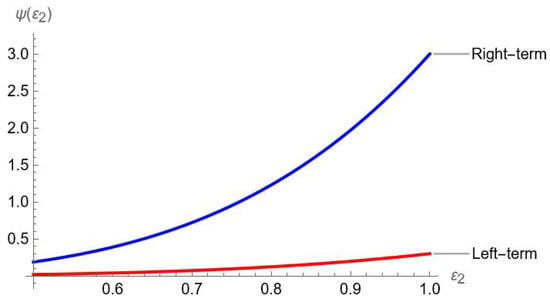
Figure 1.
Visual analysis of Theorem 4.

Table 1.
Comparison between left and right terms of Theorem 4.
Theorem 5.
Let be a twice differentiable function. If is a convex function, then
where
and such that .
Proof.
From (10), we have
Using Young’s inequality, we have
Using the convexity of , we have
This completes the proof. □
Example 2.
Let be a convex function and defined as . Additionally, is also convex function and satisfying all the requirements of Theorem 5. Then we have the following graphical representations.
Both Figure 2 and Table 2 provide the simulative and numerical verification of Theorem 5, respectively.
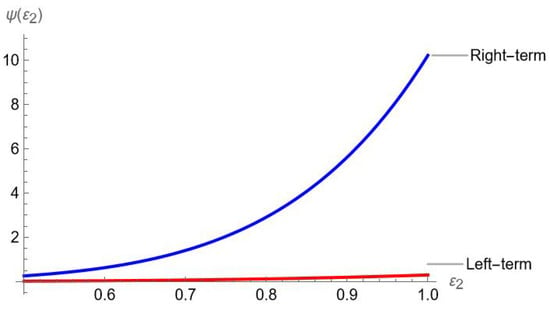
Figure 2.
Visual analysis of Theorem 5.

Table 2.
Comparison between left and right terms of Theorem 5.
Theorem 6.
Let be a twice differentiable function. If is a convex function, then
is defined in Theorem 5 and such that .
Proof.
From (10), we have
Using Hölder’s inequality, we have
Now using the convexity of , we have
This completes the proof. □
Example 3.
Let be a convex function and defined as . Additionally, is also convex function and satisfying all the requirements of Theorem 6. Now we have the following graphical representations.

Figure 3.
Visual analysis of Theorem 6.

Table 3.
Comparison between left and right terms of Theorem 6.
Theorem 7.
Let be a twice differentiable function. If is a convex function, then
where .
Proof.
By using power mean inequality on (10), we have
Now using convexity of , we have
This completes the proof. □
Example 4.
Let be a convex function and defined as . Additionally, is also convex function and satisfying all the requirements of Theorem 7. Now we have the following graphical representations.
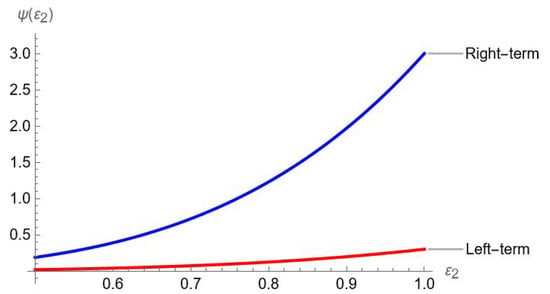
Figure 4.
Visual analysis of Theorem 7.

Table 4.
Comparison between left and right terms of Theorem 7.
Theorem 8.
Suppose that is a function of bounded variations on . Then
Here represents the total variation of on .
Proof.
From (9), we have
Now, we revisit the fact that if is the function of bounded variation and g is be a continuous function. Then exists and
By using this definition, we have
It finishes the proof. □
Example 5.
Let be a convex function and defined as . Additionally, is also convex function and satisfying all the requirements of Theorem 8. Now we have the following graphical representations.
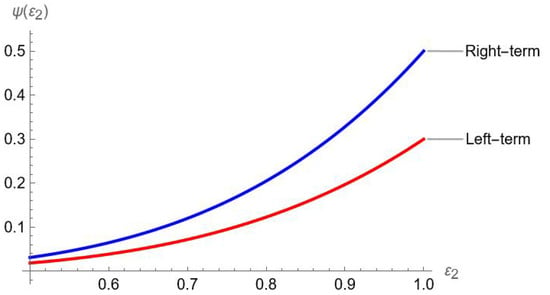
Figure 5.
Visual analysis of Theorem 8.

Table 5.
Comparison between left and right terms of Theorem 8.
2.2. Simpson’s like Inequalities
Theorem 9.
Let be a twice differentiable function. If is a convex function, then
Proof.
Substituting , and in (3) and , in (4), we have
Adding (12), (13) and (14), we have
Integrating (3) and (4) with respect to from to and multiplying by and , respectively, we obtain
Adding (16) and (17), we have
Subtracting (18) from (15), we have
By using the definition of Green’s function, we have
Let and , then
Using the properties of absolute value and triangle inequality, we have
Using the convexity of , we have
It end the proof. □
Example 6.
Let be a convex function and defined as . Additionally, is a convex function and satisfying all the requirements of Theorem 9. Now we have the following graphical representations.
Both Figure 6 and Table 6 provide the both visual and numerical illustration of Theorem 9, respectively.
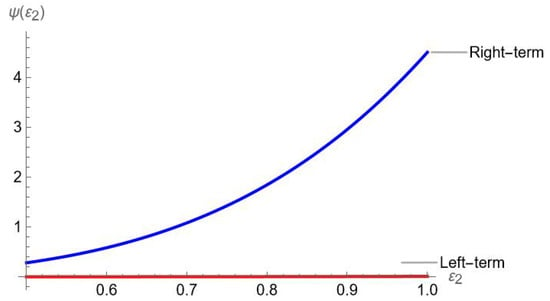
Figure 6.
Visual analysis of Theorem 9.

Table 6.
Comparison between left and right terms of Theorem 9.
Corollary 1.
By choosing in (11), we get the following bound for midpoint inequality
Theorem 10.
Let be a twice differentiable function. If is a convex function, then
where
and such that .
Proof.
By using Young’s inequality and (20), we have
Now using the convexity of , we have
This completes the proof. □
Example 7.
Let be a convex function and defined as . Additionally, is a convex function and satisfying all the requirements of Theorem 10. Then we have the following graphical representation.

Figure 7.
Visual analysis of Theorem 10.

Table 7.
Comparison between left and right terms of Theorem 10.
Theorem 11.
Let be a twice differentiable function. If is a convex function, then
where is defined in previous Theorem 10, and such that .
Proof.
Applying Hölder’s inequality on (20), we have
Now using the convexity of , we have
This completes the proof. □
Example 8.
Let be a convex function and defined as . Additionally, is also convex function and satisfying all the requirements of Theorem 11. Now we have the following graphical representation.
From Figure 8 and Table 8, it is clear that right hand side of Theorem 11 is greater than its left side.
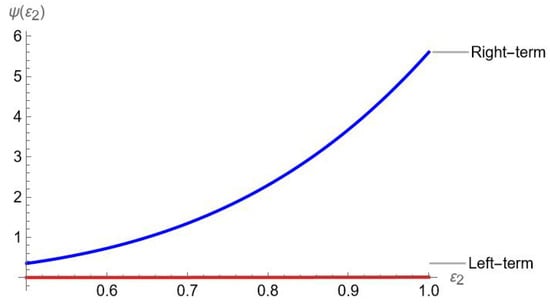
Figure 8.
Visual analysis of Theorem 11.

Table 8.
Comparison between left and right terms of Theorem 11.
Theorem 12.
Let be a twice differentiable function. If is a convex function, then
where .
Proof.
Applying power mean inequality on (20), we have
Now using the convexity of , we have
This completes the proof. □
Example 9.
Let be a convex function and defined as . Additionally, is a convex function and satisfying all the requirements of Theorem 12. Now we have the following graphical representations.

Figure 9.
Visual analysis of Theorem 12.

Table 9.
Comparison between left and right terms of Theorem 12.
Theorem 13.
Suppose that is a function of bounded variations on . Then
Here represents the total variation of on .
Proof.
From (19), we have
Now, we revisit the fact that if and is the function of bounded variation and g is be a continuous function. Then exists and
By using this definition, we have
Hence, the intended inequality is proved. □
Example 10.
Let be a convex function and defined as . Additionally, is a convex function and satisfying all the requirements of Theorem 13. Then we have the following graphical representations.
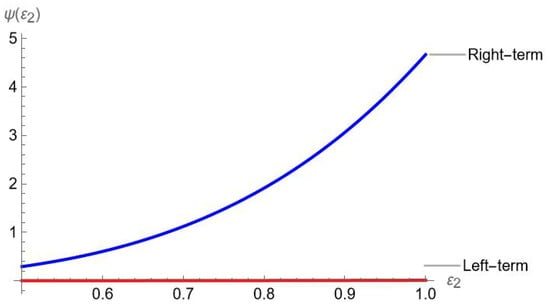
Figure 10.
Visual analysis of Theorem 13.

Table 10.
Comparison between left and right terms of Theorem 13.
Corollary 2.
For , the Theorem 13 results the following estimate of left-Hadamard’s inequality,
3. Application to Means
Now, we develop some relations between means using the results proved in previous section.
For two positive numbers and , define
These means are, respectively, called the arithmetic, geometric, harmonic, generalized logarithmic, and identric means of two positive number and .
Proposition 1.
Let , then we have the following inequality
Proof.
The assertion follows directly from (5) for . □
Proposition 2.
Let , then we have the following inequality
Proof.
The assertion follows from (5) for . □
Proposition 3.
Let , then we have the following inequality
Proof.
The assertion follows from (5) for . □
Proposition 4.
Let , then we have the following inequality
Proof.
The assertion follows from (11) for . □
Proposition 5.
Let , then we have the following inequality
Proof.
The assertion follows from (11) for . □
Proposition 6.
Let , then we have the following inequality
Proof.
The assertion follows from (11), for and . □
4. Composite Trapezoidal and Simpson’s Inequalities
Here, we generalize the estimates developed in the main section for composite trapezoidal’s rule. To conclude these bounds, consider the division of such that , where be subinterval of . Let and are the differences for trapezoidal and Simpson’s rules respectively.
and
where and are the remainder terms of trapezoidal and Simpson’s rules respectively.
Proposition 7.
Considering Theorem 4, we have the following estimate
Proof.
By applying Theorem 4 over and taking sum from to results the desired estimates. □
Proposition 8.
Considering Theorem 8, we have the following estimate
Proof.
By applying Theorem 8 over and taking sum from to results the desired estimates. □
Proposition 9.
Considering Theorem 9, we have the following estimate
Proof.
By applying Theorem 9 over and taking sum from to results the desired estimates. □
Proposition 10.
Considering Theorem 13, we have the following estimate
Proof.
By applying Theorem 13 over and taking sum from to results the desired estimates. □
5. Concluding Remarks and Future Insights
Over the years, an immense number of strategies have been applied to conclude the sharp and upper estimates of various existing inequalities within different frameworks. In this investigation, we have concluded novel upper bounds of Simpson-like inequalities through convex and bounded variation function. From examples, we have noticed that results obtained leveraging the concept of bounded variation are sharp as compared to others. Moreover, the accuracy of proposed bounds is affirmed through simulations and examples of composite rules and relations between binary means. Following the idea and strategy in the paper, one can assess the error analysis of Newton’s, Boole’s, Maclaurin’s and Weddle’s quadrature procedures. In the future, we will focus on quantum and symmetric quantum analysis of Newton-Cotes schemes by taking into account the Green function approach. One of the potential research problems is to analyze the bounds of fractional integral and derivative operators.
Author Contributions
Conceptualization, M.Z.J.; methodology, A.A. and M.U.A.; software, A.A.; validation, O.M.A.; formal analysis, M.Z.J.; investigation, M.Z.J., A.A., M.U.A. and O.M.A.; resources, L.J.; data curation, M.U.A.; writing—original draft, M.Z.J.; writing—review editing, M.Z.J. and M.U.A.; visualization, A.A.; supervision, L.J.; project administration, O.M.A.; funding acquisition, L.J. All authors have read and agreed to the published version of the manuscript.
Funding
This research was funded by TAIF University, TAIF, Saudi Arabia, Project No. (TU-DSPP-2024-258).
Acknowledgments
The authors extend their appreciation to TAIF University, Saudi Arabia, for supporting this work through project number (TU-DSPP-2024-258. The authors are grateful to the editor and the anonymous reviewers for their valuable comments and suggestions.
Conflicts of Interest
The authors declare no conflicts of interest.
References
- Pecaric, J.E.; Proschan, F.; Tong, Y.L. Convex Functions, Partial Orderings, and Statistical Applications; Academic Press: San Diego, CA, USA, 1992. [Google Scholar]
- Dragomir, S.S.; Agarwal, R. Two inequalities for differentiable functions and applications to special means of real numbers and to trapezoidal formula. Appl. Math. Lett. 1998, 11, 91–95. [Google Scholar] [CrossRef]
- Kirmaci, U.S. Inequalities for differentiable functions and applications to special means of real numbers and to midpoint formula. Appl. Math. Comput. 2004, 147, 137–146. [Google Scholar] [CrossRef]
- Dragomir, S.S.; Pearce, C.E.M. Quasi-convex functions and Hadamard’s inequality. Bull. Aust. Math. Soc. 1998, 57, 377–385. [Google Scholar] [CrossRef]
- Niculescu, C.P.; Persson, L.E. Old and new on the Hermite-Hadamard inequality. Real Anal. Exch. 2003, 29, 663–685. [Google Scholar] [CrossRef]
- El Farissi, A. Simple proof and refinement of Hermite-Hadamard inequality. J. Math. Inequal. 2010, 4, 365–369. [Google Scholar] [CrossRef]
- Gao, X. A note on the Hermite-Hadamard inequality. J. Math. Inequal. 2010, 4, 587–591. [Google Scholar] [CrossRef]
- Dragomir, S.S.; Pearce, C. Selected topics on Hermite-Hadamard inequalities and applications; Science Direct Working Paper. 2003, S1574-0358-04. Available online: https://ssrn.com/abstract=3158351 (accessed on 12 April 2018).
- Chu, Y.M.; Awan, M.U.; Javed, M.Z.; Brahim, K.; Noor, M.A.; Raissouli, M.; Khan, A.G. Analytic inequalities involving weighted exponential Ψ–beta functions and applications. J. Math. Inequal. 2024, 18, 79–101. [Google Scholar] [CrossRef]
- Yang, G.S.; Tseng, K.L. On certain integral inequalities related to Hermite–Hadamard inequalities. J. Math. Anal. Appl. 1999, 239, 180–187. [Google Scholar] [CrossRef]
- Acu, A.M.; Gonska, H.; Rasa, I. Gruss–type and Ostrowski–type inequalities in approximation theory. Ukr. Math. J. 2011, 63, 843–864. [Google Scholar] [CrossRef]
- Cheng, X.L. Improvement of some Ostrowski–Gruss type inequalities. Comput. Math. Appl. 2001, 42, 109–114. [Google Scholar] [CrossRef]
- Davis, P.J.; Rabinowitz, P. Methods of Numerical Integration; Academic Press: New York, NY, USA, 1975. [Google Scholar]
- Dragomir, S.S.; Agarwal, R.P.; Cerone, P. On Simpson’s inequality and applications. J. Inequal. Appl. 1999, 2, 533–579. [Google Scholar] [CrossRef]
- Pecaric, J.; Varosanec, S. A note on Simpson’s inequality for functions of bounded variation. Tamkang J. Math. 2000, 31, 239–242. [Google Scholar] [CrossRef]
- Liu, Z. An inequality of Simpson type. Proc. R. Soc. A Math. Phys. Eng. Sci. 2005, 461, 2155–2158. [Google Scholar] [CrossRef]
- Chu, Y.M.; Awan, M.U.; Javed, M.Z.; Khan, A.G. Bounds for the remainder in Simpson’s inequality via n-polynomial convex functions of higher order using Katugampola fractional integrals. J. Math. 2020, 2020, 4189036. [Google Scholar] [CrossRef]
- Vivas-Cortez, M.; Javed, M.Z.; Awan, M.U.; Noor, M.A.; Dragomir, S.S. Bullen-Mercer type inequalities with applications in numerical analysis. Alex. Eng. J. 2024, 96, 15–33. [Google Scholar] [CrossRef]
- Rangel-Oliveros, Y.; Nwaeze, E. Simpson’s type inequalities for exponentially convex functions with applications. Open J. Math. Anal. 2021, 5, 84–94. [Google Scholar] [CrossRef]
- Ali, M.A.; Soontharanon, J.; Budak, H.; Sitthiwirattham, T.; Feckan, M. Fractional Hermite-Hadamard inequality and error estimates for Simpson’s formula through convexity with respect to a pair of functions. Miskolc Math. Notes 2023, 24, 553–568. [Google Scholar] [CrossRef]
- Javed, M.Z.; Awan, M.U.; Bin-Mohsin, B.; Budak, H.; Dragomir, S.S. Some classical inequalities associated with generic identity and applications. Axioms 2024, 13, 533. [Google Scholar] [CrossRef]
- Alomari, M. New error estimations for the Milne’s quadrature formula in terms of at most first derivatives. Konuralp J. Math. 2013, 1, 17–23. [Google Scholar]
- Vivas-Cortez, M.; Asif, U.; Javed, M.Z.; Awan, M.U.; Almalki, Y.; Alsalami, O.M. A new approach to error inequalities: From Euler–Maclaurin bounds to cubically convergent algorithm. AIMS Math. 2024, 9, 35885–35909. [Google Scholar] [CrossRef]
- Djenaoui, M.; Meftah, B. Milne type inequalities for differentiable s–convex functions. Honam Math. J. 2022, 44, 325–338. [Google Scholar]
- Alomari, M.W.; Dragomir, S.S. Various error estimations for several Newton–Cotes quadrature formulae in terms of at most first derivative and applications in numerical integration. Jordan J. Math. Stat. 2014, 7, 89–108. [Google Scholar]
- Agarwal, R.P.; Wong, P.J. Error Inequalities in Polynomial Interpolation and Their Applications; Springer: Berlin/Heidelberg, Germany, 2012; Volume 262. [Google Scholar]
- Mehmood, N.; Agarwal, R.P.; Butt, S.I.; Pecaric, J. New generalizations of Popoviciu-type inequalities via new Green’s functions and Montgomery identity. J. Inequal. Appl. 2017, 2017, 108. [Google Scholar] [CrossRef] [PubMed]
- Vasic, P.M.; Stankovic, L.R. Some inequalities for convex functions. Math. Balk. 1976, 6, 281–288. [Google Scholar]
- Butt, S.I.; Mehmood, N.; Pecaric, J. New generalizations of Popoviciu type inequalities via new Green functions and Fink’s identity. Trans. A. Razmadze Math. Inst. 2017, 171, 293–303. [Google Scholar] [CrossRef]
- Siddique, N.; Imran, M.; Khan, K.A.; Pecaric, J. Difference equations related to majorization theorems via Montgomery identity and Green’s functions with application to the Shannon entropy. Adv. Differ. Equ. 2020, 2020, 430. [Google Scholar] [CrossRef]
- Iqbal, A.; Khan, M.A.; Mohammad, N.; Nwaeze, E.R.; Chu, Y.M. Revisiting the Hermite-Hadamard fractional integral inequality via a Green function. AIMS Math. 2020, 5, 6087–6108. [Google Scholar] [CrossRef]
Disclaimer/Publisher’s Note: The statements, opinions and data contained in all publications are solely those of the individual author(s) and contributor(s) and not of MDPI and/or the editor(s). MDPI and/or the editor(s) disclaim responsibility for any injury to people or property resulting from any ideas, methods, instructions or products referred to in the content. |
© 2025 by the authors. Licensee MDPI, Basel, Switzerland. This article is an open access article distributed under the terms and conditions of the Creative Commons Attribution (CC BY) license (https://creativecommons.org/licenses/by/4.0/).